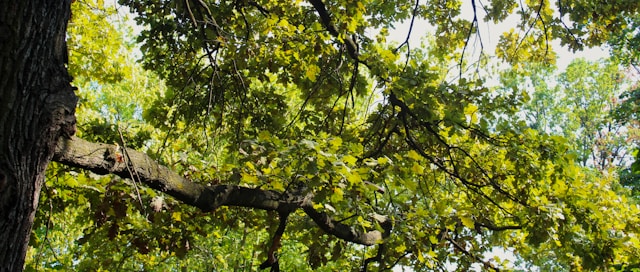White oak trees are magnificent, stately, and large. If you’re looking for a wise, slow-growing tree that withstands harsh weather and a variety of soil conditions, you won’t find one as alluring as the white oak. Let’s look at what makes these trees so special, and whether you should incorporate them into your home landscape (spoiler: the answer is “yes!”)
What Does a White Oak Look Like?
White oaks are tall and strong deciduous trees, with a wide-spreading crown that’s filled with dark green leaves. Each leaf is four to eight inches long, with finger-like lobes on each side and at the top. During the fall, leaves turn to a wine-red or bright orange-red color that’s magnificently beautiful and slowly fall to the ground as the wind blows late in the season.
The bark of a white oak tree is light grey, with scaly plates and ridges. When a white oak tree has been established for around 20 years, it begins to produce acorns and continues to do so each year until the tree is around 100 years old.
Where Does it Grow?
White oak trees can grow in hardiness zones 3 through 9, which means they can thrive in most areas throughout Colorado. In fact, they grow well in many climates throughout North America. They can be found as far north as Minnesota and Canada, and as far south as Florida and Eastern Texas. Thanks to their adaptability and hardiness, white oak trees can grow in a variety of soil conditions and moisture levels.
How Big Does it Get?
These trees are known for their stately beauty, and at maturity, reach heights of 50 to 80 feet. Equally impressive, white oak trees have a spread that’s just as wide as they are tall, offering ample shade for your yard. They grow at a moderately slow rate, with height increases of around 12 to 24 inches per year.
White oak trees have a very long tap root, which ensures that the trunk is strong, but because of this, it’s best to transplant them as very young trees.
What Does it Need to Grow?
White oak trees are slow-growing and long-lasting, thanks to their incredible tolerance and adaptability. They are great for creating dense shade areas across your landscaping with the potential to keep your home cooler in the hot Colorado summer months.
What Type of Soil Does it Need?
These trees can adapt to most soil types, but they grow best in slightly acidic soil that’s deep, moist, and well-drained. They tolerate moderate droughts and wet soil conditions but are intolerant of alkaline soil and soil that is disturbed by construction or other urban activities. In fact, alkaline soils with high pH levels in the soil can cause a white oak tree to develop chlorosis.
How Much Light Does it Need?
White oak trees grow best in places where they can receive direct sunlight throughout the day. They can also thrive in partial shade areas, as long as they receive at least four hours of unfiltered sunlight per day.
Are White Oak Trees Native to Colorado?
There is only one type of oak tree species that is a native tree to Colorado. White oak trees are native to eastern and central North America, but they can grow in hardiness zones 3 through 9. They can be found as far north as Canada and in southern states like Florida, and they span from East Texas to southern Maine.
Interesting Facts
- White oak trees are massive, strong, and hardy, and they can grow to become very mature trees living for hundreds of years.
- Their acorns provide food for birds, hoofed wildlife, and rodents alike.
- The oak leaf buds of a white oak tree are eaten by several species of birds and deer.
- Lumber from white oak trees was used to build the famous USS Constitution (also known as “Old Ironsides”).
- White oak trees provide the best wood for barrels used to store wine and whiskey. That’s because it’s strong, long-lasting, and contains tiny tissues called tyloses to keep the liquid inside the barrel where it belongs.
If you want to know more about white oak trees or any other tree, contact us at American Arbor Care today!

